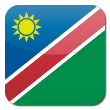Wilderness is indeed the Khaudum’s comparative advantage. The park, situated in north-eastern Namibia bordering Botswana, has less than 3 000 visitors annually and there are few tracks through the deep Kalahari sand. More elephants than people are seen around the park. It is a refuge for African Wild dog and Roan antelope, Lion, Cheetah and Leopard are also found here.
The park is unfenced except along the Botswana border, so game are able to move freely between neighbouring conservancies and small scale farms. Hence, Park staff co-operate with the conservancies in the joint management of the wildlife.
Park size: 3 842 km²
Proclamation: 1989
Natural features: Kalahari sandveld with omurambas (fossil drainage lines) which act as ideal routes for wildlife.
Vegetation: Tree and Shrub Savannah Biome. Dominant trees include leadwood (Combretum imberbe), evergreen false mopane (Guibourtia coleosperma), various acacia species including Camel-thorn trees (Acacia erioloba), Zambezi teak (Baikiaea plurijuga), tamboti (Spirostachys africana) and baobab (Adansonia digitata).
Wildlife: Elephant, Roan antelope, Giraffe, Eland, Tsessebe, Reedbuck, Lion, African wild dog, Leopard, Spotted hyaena, Ostrich, Blue wildebeest, Red hartebeest, Kudu, Oryx, Warthog, Side-striped jackal and various other smaller species. A total of 320 bird species have been recorded, including Ground Hornbill, African Hobby Falcon, Racket-tailed Roller and Bradfield’s Hornbill. Abdim’s Stork, Yellow-billed Kite, Steppe and Lesser Spotted Eagles, and African Golden Oriole birds visit during summer.
Game viewing, bird-watching. There is a campsite for tourists at Khaudum and a new lodge under construction. Twelve artificial water holes, two natural fountains and several game-viewing hides. At least two 4×4 vehicles are recommends per party, at least three days’ worth of food rations per person and 100 litres of water per vehicle.

